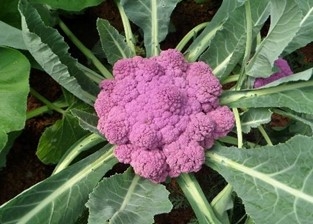Even though you may still be harvesting loads of vine-ripened tomatoes, peppers and other summer grown vegetables, in September it's time to make room for winter garden vegetables. If you delay, you may miss the chance to harvest full-sized heads of broccoli, cauliflower, and Romanesco.

Gardeners who make the mistake of waiting until the tomato plants have stopped producing ripe fruits before planting broccoli, cauliflower, or Romanesco seedlings are often disappointed by the results. When planted too late, these winter vegetables crops may produce only small “button-sized” heads, a phenomenon known as “buttoning." To produce full-sized heads, the plants need to grow plenty of large leaves while day-time temperatures still are well above 70 degrees and daylight hours have not diminished. The robust leaves are necessary to supply sufficient photosynthesis to energize the plants to produce full-sized heads.
When crops are planted too late, the plant leaves are still too small to create sufficient energy when the plant begins to produce the immature flower stalks that will eventually be harvested as a head of broccoli, cauliflower, or Romanesco. Consequently, the heads that are produced remain small.
So don't delay. It may be time to remove the squash or bean plants and substitute one or more of these brassica plants. In Contra Costa County, broccoli, cauliflower, and Romanesco can be planted as early as August and as late as mid to late September. The crops should be placed in the garden as sturdy seedlings. If you want to start your own seedlings from seeds instead of buying seedlings from a nursery, plan to start even earlier. You will need about six weeks to grow the seeds and harden up the plants to be ready to go into the garden. Be sure to provide good cultural care for the seedlings since any type of stress can also cause the plants to button.
When you put the seedlings into the garden, it would be a good idea to cover the plants with shade cloth or light-weight row covers. An internet search for “garden row covers” or “garden shade cloth” will help you find places to buy the covers. And a second search for “how to make hoops for row covers” will lead to videos and articles that show you simple ways to support the covers. Choose a row cover that will allow at least 70% of the sunlight to pass through so that the seedlings will receive sufficient sunlight to grow robustly.
The row covers will help protect the seedlings from the high daytime temperatures that many areas of the County receive in September. An added bonus is that the row covers keep the cabbageworm butterflies away from the seedlings so that they cannot lay eggs on the leaves that will quickly hatch into caterpillars with voracious appetites for the plant leaves.
If you miss the August–September window for planting, don't give up on growing brassica vegetables this year. Kohlrabi, cabbage, and kale are more forgiving and can be grown successfully if seedlings are placed in the garden in October.

Incidentally, September is also the time to plant seeds to grow carrots, beets, parsnips, and other root crops. No room in the garden? Containers work well for all the root crops.
Worried about using water for a winter garden during a drought? Keep in mind that you should always have plants growing in your garden beds to maintain healthy soils. After summer crops are removed, you can grow cool season vegetables or plant cover crops. Cool season crops use much less water than summer crops. A vegetable plant that is 2 feet wide growing in Pleasant Hill needs 2 gallons per week in July, but a vegetable plant of equal size needs less than half a gallon per week in November and even less in December and January. With cooler fall and winter temperatures and a good layer of mulch below your winter crops, even occasional rain can keep the soil moist and provide the needed water.
For guidance on growing cool season crops, use this website and click on the crop you want to plant: https://cagardenweb.ucanr.edu/Vegetables/
For advice on managing pests and diseases affecting your crops, use this website and click on the vegetable name: http://ipm.ucanr.edu/PMG/GARDEN/veggies.html
Help Desk of the UC Master Gardener Program of Contra Costa County (TKL)
